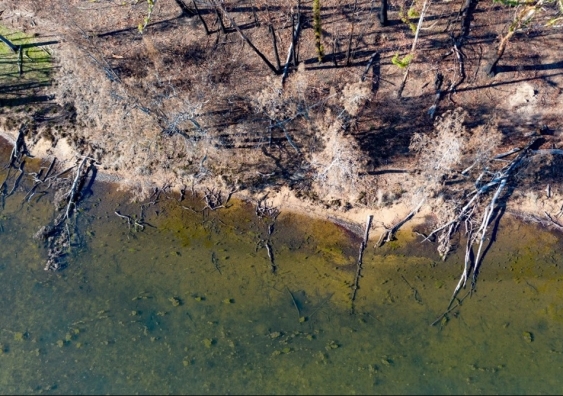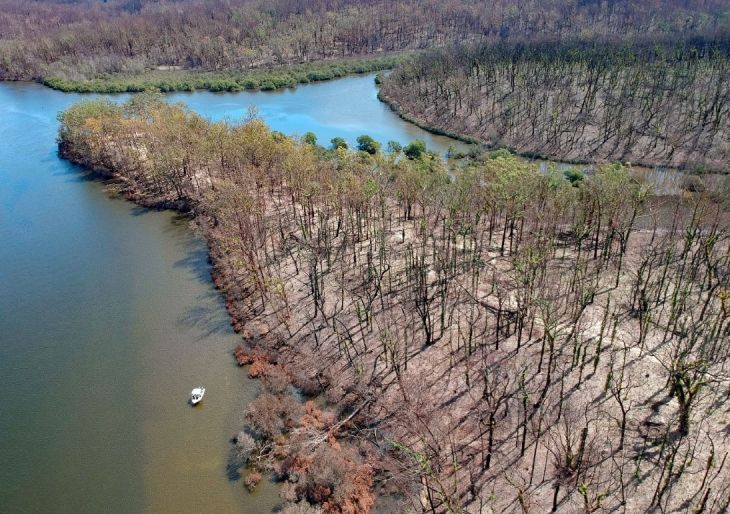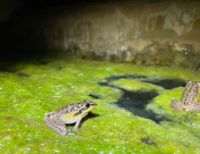The influence of megafires on estuaries, one of earth's most valuable biomes
The burnt zone at Clyde River, Batemans Bay, reaches all the way to the edge of the water. Photo credit: John Turnbull.
Estuaries – where rivers meet the sea – are some of the most valuable habitats on earth. As well as being biologically diverse and productive places, they are host to ports and a significant portion of the world’s population.
Researchers from UNSW Sydney, University of Sydney, CSIRO and Macquarie University have explored the effects of bushfires on estuaries in New South Wales, finding fires can increase the load of fire-derived pollutants with potentially profound environmental effects.
The study, published recently in Environmental Pollution, is the first to empirically demonstrate the influence of the 2019–2020 Australian wildfires on estuarine sediments and the potential of damage from wildfires on coastal habitats more generally. Unlike regular bushfires, megafires such as those during Australia’s 2019-2020 ‘Black Summer’ can surround estuaries.
The researchers surveyed estuaries along NSW’s coast from Bateman’s Bay in the south to Port Macquarie in the north before and after the wildfires of 2019/20. For those estuaries without a buffer of vegetation, the researchers found an increase in metals, pyrogenic carbon (carbon formed by fires), and potentially disruptive nutrient content, like phosphorus and nitrogen.
“Considering that excessive nutrient input is one of the main stressors on estuaries, the changes found in our study might have serious implications due to its potential to alter ecological and physico-chemical processes,” said lead author Thayanne Barros, PhD candidate from UNSW’s School of Biological, Earth & Environmental Sciences.
A rapid increase in the concentration of nutrients, metals and pyrogenic carbon in nearshore areas could affect the behaviour, survival and reproduction of estuarine species. Filter-feeding animals such as mussels and oysters, especially, are sensitive to the levels of silt, which increased after the fires.
Senior author Professor Emma Johnston, a marine ecosystems expert and the Deputy Vice-Chancellor (Research) at the University of Sydney, said in some catchments, more than 90 per cent of the vegetation was burnt, and the fire went right down to the waters’ edge, leading to a massive amount of pollution in the form of sediment, metals and nutrients entering our waterways.
“If there is consistent flushing of the estuary then these trace elements will prime them for productivity. However, if water flow is low and flushing is minimal, they can cause microalgae to breed exponentially, leading to plankton blooms that deplete oxygen supplies and kill fish, with a domino effect on the entire ecosystem,” Professor Johnston said.
Among the six estuaries surveyed, some had a ‘buffer’ of vegetation surrounding the water (known as the ‘riparian zone’), while others were without a buffer. The study found that those estuaries with an intact riparian zone were significantly protected from the fire-induced pollution.

Post-fire rainfall and runoff leads to the input of ash, nutrients and metals in affected estuaries. Photo credit: John Turnbull.
Bushfires and future river management
With current climate projections suggesting megafires like Black Summer will occur more frequently in Australia and around the world, the authors say governments must factor our vital estuary habitats into their fire prevention and management plans.
The study also revealed how much pyrogenic carbon was deposited in estuaries – the bushfires’ calling card. Now that climate change is increasing the extent and severity of wildfires around the world, the concentrations of pyrogenic carbon that cause harm should be the subject of further study, according to Professor Johnston.
The researchers say their findings prompt a call for riverside vegetation to be prioritised for protection and that bushfires be considered in catchment management plans.
Definitions of 'bushfire', 'wildfire' and 'megafire'
The terms 'bushfire' and 'wildfire' are not synonymous nor is wildfire an Americanisation of bushfire. "A 'wildfire' is a fire that isn't planned," says a Queensland Fire and Emergency Services spokesman. Other experts describe wildfires as uncontained bushfires. A megafire is generally a wildfire whose size exceeds 10,000 hectares (sometimes 40,000 hectares in the US).
About the study
The researchers studied six estuaries on the New South Wales coast, at the mouths of the Hastings, Karuah, Georges, Shoalhaven, Clyde and Moruya rivers immediately before the fires.
“We had just finished collecting samples for a different project when the fires started, so we saw a unique opportunity to conduct a Before-After-Control-Impact study in these areas. The initial samples became our ‘before the fires’ dataset and when the fires ceased we collected the samples for our ‘after the fires dataset’,” Ms Barros said.
To investigate the potential impacts of bushfires on estuaries, the researchers decided to focus on the soft muddy bottom of the estuaries since this habitat is an important source and sink of elements and plays a major role in global biogeochemical cycles, simultaneously supporting high biodiversity and productivity.
They analysed the sediments to check for changes in nutrient concentrations, sediment silt content, metals, and different forms of carbon, including pyrogenic carbon (formed by fires) to directly link changes in carbon concentration to the bushfires.
Estuaries were categorised according to the percentage of the catchment vegetation that was burnt and the proximity of the burnt zone to the waterway.
The study shows that in those estuaries with a large proportion of the catchment burnt and little gap between the fire and the waterway, the concentration of different forms of carbon, nutrients, metals and silt content significantly increased after the fires. While no significant changes were detected in the unburnt estuaries or those that retained a buffer zone.
The study received funding from the World Wide Fund for Nature (WWF).







